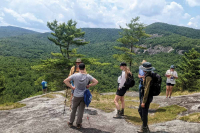Yoga is about stress relief, not acrobatics
 By Katie Reeder • SMN Intern
By Katie Reeder • SMN Intern
It’s a myth that yoga is reserved for only the most acrobatic of people. And that’s good news considering the amount of stress that is often part of everyday life, said Jay MacDonald, a registered yoga teacher out of Waynesville.
Treating the spine, easing the pain
 A little bit goes a long way. That’s a key philosophy at Blue Mountain Chiropractic Center in downtown Waynesville. Good health doesn’t have to be an uphill battle. Rather, it can be an easy stride with the right preventative measures in place, within your body and mind.
A little bit goes a long way. That’s a key philosophy at Blue Mountain Chiropractic Center in downtown Waynesville. Good health doesn’t have to be an uphill battle. Rather, it can be an easy stride with the right preventative measures in place, within your body and mind.
Keep moving: Huskey helps women get healthy
 Sussy Huskey has learned that life can take you in many directions — some planned and others unexpected — but the important thing is to keep moving.
Sussy Huskey has learned that life can take you in many directions — some planned and others unexpected — but the important thing is to keep moving.
Conference highlights native culture as integral to addressing health issues
 It was a century ago that Beverly Kiohawiton Cook’s relative was taken from his family and shipped off to Carlisle Indian School in Pennsylvania. Those years at school, days of travel away from family and forbidden to use native dress and speech, were traumatic.
It was a century ago that Beverly Kiohawiton Cook’s relative was taken from his family and shipped off to Carlisle Indian School in Pennsylvania. Those years at school, days of travel away from family and forbidden to use native dress and speech, were traumatic.
Sponsored: Controlling sodium in your diet
 QUESTION: I have high blood pressure and have been told to cut down on salt and sodium. What should I be looking at on the label?
QUESTION: I have high blood pressure and have been told to cut down on salt and sodium. What should I be looking at on the label?
Answer: One of the key recommendations of the 2010 Dietary Guidelines for Americans is: "Reduce daily sodium intake to less than 2,300milligrams (mg) and further reduce intake to 1,500 mg among persons who are 51 and older and those of any age who are African American or have hypertension, diabetes, or chronic kidney disease."
WCU professor studies healthy eating demographics
 Green space and gardens dominate much of the Western North Carolina landscape, but what determines whether people here actually eat the fruits and veggies that abound? That’s what April Tallant, health professor at WCU, hopes to find out as she crunches the numbers from her latest research project.
Green space and gardens dominate much of the Western North Carolina landscape, but what determines whether people here actually eat the fruits and veggies that abound? That’s what April Tallant, health professor at WCU, hopes to find out as she crunches the numbers from her latest research project.
Rewarding students with fast-food coupons raises concerns
 Some schools are thinking twice about the long standing practice of passing out fast-food coupons to children as rewards.
Some schools are thinking twice about the long standing practice of passing out fast-food coupons to children as rewards.
First encephalitis case of the season reported in Franklin
Public health officials have reported that a child in Macon County has contracted LaCrosse Viral Encephalitis, a potentially serious illness carried and transmitted by mosquitoes.
While other mosquito-borne diseases such as West Nile Virus are found across the state, LaCrosse is largely confined to Western North Carolina. The disease is rarely fatal, but a Transylvania County girl died as a result of infection in 2001. And in 2009, a child in Cherokee died, adding new emphasis to health officials’ efforts to warn people about the potential dangers of LaCrosse.
There were 13 confirmed and potential cases identified in WNC in 2010.
Cherokee, in particular the Big Cove community, and Black Mountain — for unknown reasons — are recognized in the medical community as hotspots for the illness, said Dr. Penny O’Neill, a pediatrician with Sylva Pediatric Associates. But, as the case in Macon County shows, the dangers exist anywhere in the region.
The big month for outbreaks is usually August, but with one in WNC already identified, “we’ll go from now until the first killing frost” with outbreaks of LaCrosse, O’Neill said.
Stan Polanski, physician’s assistant for Macon County Public Health, said the child with LaCrosse is recovering. The last diagnosed case in Macon County was more than five years ago, he said.
Regionally, about 20 cases are reported each year.
“For every case we confirm, there are probably 20 to 50 unrecognized cases,” Polanski said.
In Cherokee, public health officials have crafted a two-part response to the problem.
On one side, they’ve long been educating parents, kids and the community at large on how to prevent mosquito’s and eliminate standing water that serves as breeding grounds.
“We’ve done mitigation in the community with everything from actually going out and doing community assessments to emptying stale water containers,” said Vickie Bradley, deputy health officer for the Eastern Band of Cherokee Indians.
Last year, the tribe also started a program in concert with Cherokee Indian Hospital to support families that are struggling with the long-road to recovery from an encephalitis infection. Dr. Anna Eastman, a consultant from the United Kingdom where there is an established post-infection support program, has come to Cherokee to train tribal health workers.
The danger posed by encephalitis is greatest for babies, O’Neill said, because they can have potentially devastating neurological issues. The intensity of the illnesses seem to vary from year to year, she said, but emphasized there is one important step people can take: Use DEET.
O’Neill said parents often express concerns about the mosquito repellent, but “the danger from DEET is potential — the danger from encephalitis is real.”
The object, the pediatrician said, is to eliminate mosquito bites, not just reduce the number received.
By Quintin Ellison and Colby Dunn • Staff writers
LaCrosse Viral Encephalitis
Symptoms occur from a few days to a couple of weeks after being bitten by an infected mosquito. These symptoms include fever, headache, nausea and vomiting. In more severe cases, convulsions, tremors and coma can occur. Children under 16 years of age and the elderly are the most susceptible to the disease.
To reduce mosquito breeding areas:
• Remove any containers that can hold water.
• Keep gutters clean and in good repair.
• Repair leaky outdoor faucets and change the water in birdbaths and pet bowls at least twice a week.
• Use screened windows and doors and make sure screens fit tightly and are not torn.
• Keep tight-fitting screens or lids on rain barrels.
Partner institutions reaffirm commitment to Native health
Western Carolina University, Wake Forest University and the Eastern Band of Cherokee Indians have reaffirmed their partnership to promote Native health initiatives.
Since 2006, the three institutions have collaborated to support the Culturally Based Native Health Program, or CBNHP. The CBNHP has two components: a graduate and undergraduate Native health certificate offered through WCU; and a Native youth-to-health careers initiative summer camp that takes place at Wake Forest.
“We are recommitting ourselves to initiatives we started four years ago,” said Lisa Lefler, a professor of medical anthropology and director of the WCU component of the program.
Principal Chief Michell Hicks of the EBCI, WCU Chancellor John Bardo and Provost Jill Tiefenthaler of Wake Forest formally updated the agreement at a meeting Nov. 16 on the WCU campus. Provisions of the new agreement include an extension of the terms through August 2015 and for Wake Forest to support qualified EBCI applicants. WCU agrees to “provide in-kind technological support and consultation to promote these collaborative efforts and support of American Indian students in education and career development.”
Bardo stressed the partnership’s strength and value. Tiefenthaler, citing the economy, said institutions are “in the age of partnerships.” Hicks said the tribe is interested in expanding the relationship to include other fields, such as architecture or accounting, for example.
The Native health certificate was developed with tribal community members and health professionals to provide a curriculum based on culture to inform providers about the unique nature of Indian health policy and the historical and cultural contexts of heath. This 12-hour, fully online program is one of the first in the nation to include a partnership with a Native community.
The second component of the CBNHP, the medical career counseling and technologies program, also called MedCat, responds to the universal need for more Native health care workers by recruiting high school students interested in medical careers and related technologies.
The CBNHP works in other ways to heighten awareness of Native health issues. A public lecture series featured its second speaker this fall semester, and a concert and free symposium in October raised raise awareness of the intersection of environmental, health and indigenous issues related to the destruction of mountain land.
Expansion nearly complete at Franklin Health and Fitness
A 4,000-square-foot, $800,000 expansion that includes a major renovation at the Franklin Health and Fitness Center will be finished in about eight weeks.
“We’re wrapping it up,” said Rodney Morris, the facility’s general manager.
Additions include a new aerobics room, a cardio room with updated equipment, a new women’s locker room, a remodeled and expanded men’s locker room, an enhanced spinning room, an expanded KidsZone, a redesigned service desk and a new entrance with handicap access. There will also be new paint and flooring throughout the center.
Franklin Health and Fitness Center opened at its current location on East Main Street in 1988. Rodney’s father, Dr. Ed Morris, was an original founder and is now sole owner of the center. This is the second — and by far the largest — expansion at the facility.
To build or not to build
Morris appeared before Macon County commissioners back in September 2007 at a public hearing on a countywide recreational bond referendum that, if passed, would have built a county recreation center.
Morris told commissioners then that his facility operated on a small profit margin and that any loss of members could result in Franklin Health and Fitness having to close its doors. That bond referendum ultimately failed.
Rodney Morris said that, at this time, he didn’t see a great need for another recreational center in the county and that the majority of voters must have felt the same way.
“If there wasn’t a facility already here, they [commissioners] could have made a better case,” Morris said.
Members first
Sean Callahan, owner of Wind River Construction of Franklin — the company doing the expansion — said he got an unusual request from Morris.
“They asked us to slow down a little,” he said. Callahan said the construction was done in phases to ensure members always had access to the facility.
Rodney Morris said that member access and convenience was paramount during construction. “We’re open from 5:30 a.m. to 10 p.m.,” Morris said. “Sean and his crew went above and beyond to help us accommodate our members.”
Callahan said that meant working lots of nights. “All the tile had to be laid at night,” he said. And it meant adding stages to the plan so they could come in after hours when members wouldn’t be there.
Jerry Wright has been a member for the 22 years Franklin Health and Fitness has been in business.
“I helped cut the ribbon,” Wright said.
Wright called the expansion “first class,” and said that members were inconvenienced as little a possible.
“At one time they were thinking they may have to close some to accommodate the construction, but they worked around that. I am very pleased that they didn’t have to shut down,” said Wright.
Wright said he remembers 22 years ago when he heard of plans for a new fitness center in Franklin. “I’m a racquetball player,” Wright said, “and when I heard they were gonna have racquetball courts I went down to sign up. At that time Western Carolina was the closest place to play.”
Wright said he and his family enjoy many of the amenities at Franklin Health and Fitness Center.
“My son takes karate twice a week and the pool is really a fun place for the family,” he said.
Wright said there’s nothing better on a cold winter’s Sunday afternoon than loading the family and heading to the fitness center’s 25-yard heated saltwater pool.
Building plans
Bernlohr Architects of Annapolis, Md., designed the expansion and remodeling.
“We interviewed several architects but when we talked with Jim [Bernlohr], we knew he was the best fit for us,” said Rodney Morris.
The firm had worked on more than 150 fitness centers across the country
Callahan said the plans were straightforward and the design was good.
“The architects have never had to make a site visit, everything has gone according to plan, “ Callahan said.
And those plans include a passive electric-solar design along with a natural gas backup that’s used to heat the pools and showers. The roofing, which uses light colored, reflective shingles, is LEED-certified (Leadership in Energy and Environmental Design) and hot water is provided by energy-star certified tank-less hot water heaters.
Morris said the architect, the builder and the sub-contractors were all knowledgeable and comfortable using the latest technology to help create an environmentally friendly environment. Morris said the green building design not only makes sense from an environmental standpoint but that it is also money-saving in the long run.
Meeting needs
Rodney Morris said the driving force behind the expansion was meeting needs.
“Our membership is growing, the town of Franklin is growing and people are more health-conscious,” he said.
There are approximately 1,800 current members at Franklin Health and Fitness Center. Morris said the facility employs about 50 people, with seven full-time staff members. The expansion will likely create a few more employment opportunities.
Morris said the center is diligent in finding the best possible employees and instructors.
“We always conduct a series of interviews,” he said “and all of our instructors must present a class for co-workers before they work with members.”
“We look for instructors with experience. And many of our instructors have four-year degrees in their fields,” Morris said.
“All of our instructors must either be certified or obtain certification as a requirement for employment,” he added.
Morris said the new additions and enhancements should nearly double membership capacity at the facility. However, he said there is still room for growth.
“We own three-and-a-half acres here,” Morris said “and we are prepared to meet the needs of our members.”









